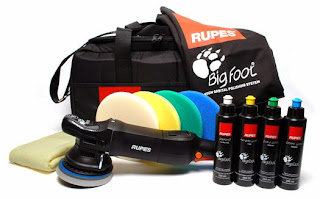If you were to apply polish to a body panel, and then place a pad on the surface and turn the machine on, it would be very difficult to control and will produce hazing. This is due to most of the pad being "dry". Polishes and compounds appear to work better when the foam pad is ‘primed’ some things to note about pad priming: the cutting ability is increased, a better finish is obtained, it reduces any product ‘flashing’ problems, it produces a more even finish and the polishing machine is less likely to hop. Use a very slightly distilled water dampened pad, not too wet (otherwise the polish will clump); then spread the polish / compound over the pad evenly
Priming / Seasoning Pads
Don’t use a quick detailer or a pad conditioner as they are usually formulated with silicones, oils, waxes, polymers, gloss enhancers, which will negatively affect the polish lubrication (exception Meguiar’s Final Inspection Spray, diluted 1:1 distilled water) spraying water while polishing can cause the foam pads abrasives to aquaplane, as water for all intents and purposes is incompressible, so that the pad and the abrasive don’t have actual surface contact, thereby negatively impacting the polishing process. Spread the polish / compound over the pad evenly and ensure it is absorbed into the foam, then spread that polish onto the pad by hand until it becomes 80% saturated.
By ensuring the pad doesn’t become saturated with polish it allows the in-built cushioning effect and the pads designed foam qualities; i.e. density (or rebound), compression (‘hardness or stiffness) and without altering its in-built air-flow, which will decrease its heat dissipating abilities, causing it to transfer more kinetic friction heat to the surface
To apply to the paint surface; lightly raise the back of the machine so you are working with the top 1/3 of the pad. After polishing for a minute or two the pad will become more evenly saturated with product and actually become softer from friction induced heat build-up (seasoned). At this point, you can safely transition from a tilted up to a flat polishing position. Every time you put a fresh pad on your machine (and this should be done often) you should prime and then season it for a minute or two before "flat" polishing.
Once the pad has been seasoned (pad should be 80% saturated with product being used to compound / polish) you can reduce the amount of polish / compound applied to the pad for subsequent passes; dependent upon what you're trying to accomplish. If you use too much polish or compound the oils will cause the surface to become over lubricated, which will negatively impact the abrasive abilities
Some advantages to pad priming:
• Increased cutting ability
• Better surface finish
• Eliminates carrier system (solvent) flashing problems
• Surface is more evenly polished and polisher is easier to control
When you prime entire pad, by spreading the abrasives uniformly and by keeping the pad flat thus ensuring constant paint / polish contact it becomes similar to a piece of wet-sanding finishing paper, the oils in the polish provide the lubrication (like the water does in wet-sanding)
Polish Lubrication
Gloss It EVP Pad Prime is high-grade lubricating oil that greatly extends machine polishing times and enables polishes to break down properly, even on the softest of paints. It helps to extend pad life and reduce the amount of polish used, and therefore pays for itself in the long run. Works exceptionally well in hot and humid conditions, where it prevents polishes from flashing off too quickly, and is also useful in cold and damp conditions, where it prevents temperature-sensitive polishes like Menzerna RD3.02 from clumping up and becoming unusable.
Designed to be used sparingly; only a single drop is required per panel to be polished; for best results, add the drop to the centre of the pad and then place the pad on to the panel to be polished and run your machine for a few seconds at low speed to spread the oil evenly over the face of the pad.
Methodology
1. Dampen the pad thoroughly (do not over wet) as this will aid in compound/polish dispersion. You could also wet the foam and press in a folded towel, do not wring the foam as this could weaken the Velcro® backing.
2. When the pad is dampened properly it becomes flexible and much easier to use, this also helps the pad to absorb polish (capillary action) efficiently. Pad longevity may be increased as the water will dilute any solvent, paint residue (oxidation) or abrasive materials as these will degrade the structure of a pad, either by mechanical agitation or by absorption.
3. Dampened foam will be less brittle and therefore less likely to tear or shred.
4. Spread the polish / compound over the pad evenly and ensure it is absorbed into the foam, then spread that polish onto the pad by hand until the pad face becomes 75 % saturated. After polishing for a minute or two the pad will become more evenly saturated spraying water onto the surface to induce capillary action to draw more abrasives to the surface of the pad for more cut.
5. Once the pad has been seasoned (pad face is 75% saturated with product) you can reduce the amount of polish / compound applied to the pad for subsequent passes; dependent upon what you're trying to accomplish.
6. Once the pad is primed it helps by spreading the abrasives uniformly and by keeping the pad flat thus ensuring constant paint / polish contact it becomes similar to a piece of wet-sanding finishing paper, the oils in the polish provide the lubrication (like the water does in wet-sanding)
Relevant Articles
1. KBM- Pad Priming and Supplemental Wetting Agents by Kevin Brown -
2.The Physics of Polishing -
http://togwt1980.blogspot.co.uk/2017/08/the-physics-of-polishing.html
3. Surface preparation prior to polishing -
http://togwt1980.blogspot.co.uk/2017/07/surface-preparation-prior-to-polishing.html

No comments:
Post a Comment